#Albertine Rift
Explore tagged Tumblr posts
Video
Purple-breasted Sunbird por Rhys Marsh
#Africa#Albertine Rift#Bird#Burundi#Kibira#National Forest#Nectarinia purpureiventris#Purple-breasted Sunbird#Regional Endemic#Sub-Saharan#male#Cibitoke#flickr#photography#birds#bird photography#animals
4 notes
·
View notes
Text

Great Lakes Bush Viper aka Nitsche’s Bush Viper (Atheris nitschei), female, family Viperidae, found in forests of the Albertine Rift of central Africa
Venomous.
photograph by Dick Bartlett
383 notes
·
View notes
Text

Excerpt from this story from Mongabay Environmental News:
Michael Harvey recalls the moment he first saw a flock of yellow-crested helmetshrikes flitting through a cloud forest in the eastern Democratic Republic of Congo: the first confirmed sighting by scientists of the species in 16 years.
“It was more bizarre and exciting than I could have imagined,” says Harvey, an ornithologist and assistant professor at the University of Texas at El Paso (UTEP).
In December 2023, he and a team of U.S. and DRC ornithologists and herpetologists trekked for weeks in cars, on motorbikes and on foot to reach the Itombwe massif, on the western edge of the Albertine Rift, a vast ecoregion of mountains, valleys and forests spanning five countries in East Africa.
Harvey and a DRC assistant had left their camp to hike up a ridge to look for cloud forest birds. When they reached a fern meadow in a natural forest clearing, rain clouds swept in, and thick swirling mist reduced visibility to around 10 meters (33 feet).
“I’m in the meadow, and inside the cloud forest, I start hearing these wild, snapping sounds and squeals that sounded like wind-up toys,” Harvey says. “Then, out of this pea-soup fog, I see these jet-black shapes, almost blacker than black, starting to emerge in the fog, and I raise my binoculars and that’s when I can see these brilliant, bright, whitish-yellow crests on the birds, the yellow eyes, the yellow eye wattles, and the pink-red legs.”
It was a small flock of six to eight yellow-crested helmetshrikes (Prionops alberti), a species he’d only previously known from books — and one that scientists hadn’t sighted since 2007.
“They were interacting with each other, making these bizarre sounds and doing acrobatics right on the edge of this clearing and then they sort of melted back into the forest and moved down the ridge.”
Finding the yellow-crested helmetshrike wasn’t the main reason Harvey went to Itombwe, though it was a “dream bird” that had been at the back of his mind alongside the Itombwe owl (Tyto prigoginei) and Itombwe nightjar (Caprimulgus prigoginei). The latter two haven’t been recorded by scientists since 1996 and 1955, respectively.
The main reason Harvey went to Itombwe was to obtain a genetic sample from the Grauer’s broadbill (Pseudocalyptomena graueri), a tiny, brilliant-green bird that’s the sole species in its genus. He succeeded: both observing a pair of Grauer’s broadbills and taking a genetic sample. But his first encounter with the helmetshrikes, and further ones the team had during the six-week-long expedition, stick vividly in his mind.
10 notes
·
View notes
Text
Unveiling Nyungwe National Park: A Birder's Paradise in Rwanda

Imagine a lush, verdant rainforest teeming with life, where the air is filled with the sweet melodies of countless birds. This is Nyungwe National Park, a true birder's paradise nestled in the heart of Rwanda. With its diverse habitats, from dense montane forests to marshy wetlands, this park is home to a captivating array of avian species, many of which are elusive and endemic to the Albertine Rift.
1. Nyungwe National Park: A Birder's Haven in Rwanda
Nyungwe National Park, located in southwestern Rwanda, is one of the country's most treasured natural areas. Spanning over 1,000 square kilometers, the park is part of the Albertine Rift, a global biodiversity hotspot. Its dense, evergreen forests are home to a staggering variety of plant and animal species, making it a haven for nature enthusiasts.
2. Encountering Rwanda's Iconic Birds
The turacos are undoubtedly Nyungwe's most iconic bird species. Their vibrant plumage, shimmering with iridescent hues, is a sight to behold. Three of the most sought-after turaco species in the park are:
Great Blue Turaco: With its deep blue plumage and striking red crest, the Great Blue Turaco is a majestic bird.
Ruwenzori Turaco: This stunning bird is characterized by its metallic green plumage and long, slender tail.
Ross's Turaco: Smaller than its relatives, Ross's Turaco has a vibrant green body with a blue head and throat.
3. Rare and Endangered Species: A Conservation Priority
Nyungwe National Park is also home to several rare and endangered bird species, including:
Red-collared Mountain Babbler: A secretive bird found in the park's montane forests.
Albertine Owlet: A small owl endemic to the Albertine Rift.
Grauer's Swamp Warbler: An elusive warbler found in the park's wetlands.
4. Colorful Forest Dwellers: A Sunbird's Paradise
Nyungwe is renowned for its diverse sunbird population, which includes some of the most colorful birds in the park:
Purple-breasted Sunbird: A vibrant bird often seen hovering at flowers.
Blue-headed Sunbird: A striking bird with a blue head and throat.
Regal Sunbird: The largest sunbird species in the park.
Rwenzori Double-collared Sunbird: An endemic sunbird found in the park's higher elevations.
5. Elusive Forest Floor Residents
While many birds in Nyungwe are found in the canopy, there are also several species that inhabit the forest floor:
Red-throated Alethe: A shy thrush often seen foraging for insects.
Archer's Ground Robin: A small robin endemic to the Albertine Rift.
Kivu Ground Thrush: A ground thrush similar in appearance to the Red-throated Alethe.
6. Best Birdwatching Spots in Nyungwe
Nyungwe National Park offers a variety of birdwatching opportunities:
Uwinka Overlook: A popular viewpoint for spotting turacos and other forest birds.
Kamiranzovu Marsh: A wetland area home to waterbirds like herons and egrets.
Karamba Trail: A challenging hike offering excellent opportunities to see forest birds.
Isumo Waterfall: A scenic waterfall where you can spot birds in the surrounding forest.
7. Optimal Seasons for Birdwatching in Rwanda
The best time to visit Nyungwe for birdwatching is during the dry season (December to March). However, the park can also be visited during the wet season (April to November).
8. Essential Birdwatching Equipment for Your Rwanda Adventure
To make the most of your birdwatching experience in Nyungwe, you'll need:
Binoculars: A good pair of binoculars is essential for observing birds.
Field guides and checklists: These will help you identify the birds you see.
Appropriate clothing and footwear: Comfortable, sturdy shoes and weather-appropriate clothing are essential.
9. Tips for Responsible Birdwatching in Rwanda
Respect bird habitats: Avoid disturbing birds and their nests.
Minimize disturbance: Keep noise levels to a minimum and avoid feeding birds.
Support local conservation efforts: Consider staying at eco-friendly lodges and contributing to conservation projects.
Nyungwe National Park is a birder's dream destination, offering a unique opportunity to witness some of the most vibrant and elusive avian species in Africa. By embarking on a Rwanda birdwatching tour, you can experience the breathtaking beauty of this natural wonder and contribute to the conservation of its incredible birdlife.
4 notes
·
View notes
Text
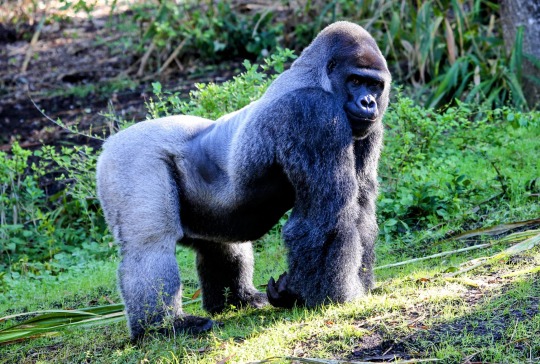
Mountain gorilla (Gorilla beringei beringei)
While most gorillas are found in lowland forests, this subspecies is found in the forested mountain regions of the Albertine Rift in central Africa. They have longer fur than other gorillas, allowing them to live in higher, colder altitudes. They eat mostly vegetation, and like other gorillas, they construct leafy nests in which to sleep. They are also very intelligent, and young individuals have been observed dismantling poachers’ traps and snares!
#markhors-menagerie#primates#apes#great apes#animal facts#fun facts#animals#biology#gorilla#mountain gorilla
32 notes
·
View notes
Text


[ID: two images, in the first, a White-naped pigeon sit in a tree. it is dark coloured with a white patch on it's head and neck, and light speckles on it's chest. the other image is of an Ashy wood pigeon, dark grey wings and tail, white head, and a bright purple neck. it is also sitting in a tree]
Off To a good start! I wonder what our next pigeons have in store for us!
This 1st pigeon has a cool hat! the White-naped pigeon is found in the mountains of Cameroon and the Albertine rift montane forests. It spends its time in trees and it rarely descends to the ground. Its scarcity and restricted/fragmented fragmented range leaves it very vulnerable to habitat loss.
The Ashy wood pigeon has a wide range throughout Southeast Asia. Will its rare and secretive nature give it an advantage in the tournament or or will its good looks win the audience over?
22 notes
·
View notes
Text
Rwanda Gorilla Safari: A Superb Opportunity To View The Mountain Gorillas
Little and compact, Rwanda is overflowing with untamed wildlife, amazing national parks, and superb scenes. The gorilla-chimpanzee trekking in Rwanda gives you an extraordinary chance to explore the national treasure. How to catch a glimpse of the typical safari creatures? Embarking on a Rwanda gorilla safari tour is imperative
Trekking to see chimpanzees and gorillas is without a doubt a feature of the Rwanda gorilla safari tour. It ensures a close encounter with the primates present in the various national parks and jungles. It is an immersive experience.
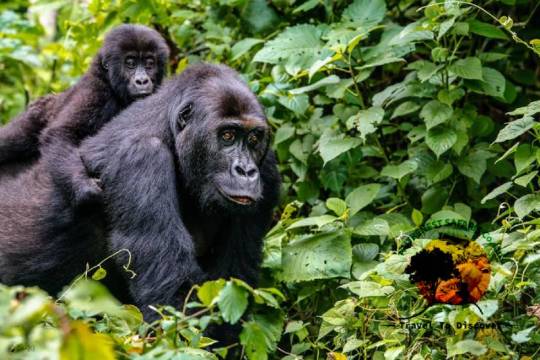
This remarkable journey will transport you to the picturesque savannah reserve in Rwanda. It is where you will encounter a diverse array of wildlife, including leopards, elephants, buffalos, zebras, lions, black and white rhinoceroses, panthers, giraffes, and an abundance of antelope species such as topi, impala, and defassa waterbuck.
Rwanda boasts three primary wildlife destinations: Volcanoes National Park, Nyungwe Forest National Park, and Akagera National Park. All of them are home to a wide range of fauna. Among these, Rwanda stands as one of the three countries where endangered mountain gorillas can be found. Observing these magnificent creatures in their native environment is an incomparable wildlife encounter. Additionally, visitors have the opportunity to track habituated chimpanzees and golden monkeys, similar to the thrilling gorilla trek. Rwanda's diverse habitats provide a sanctuary for numerous species, including mountain gorillas, chimpanzees, golden monkeys, hippos, giraffes, zebras, leopards, crocodiles, and over 600 bird species.
Volcanoes National Park is renowned for its diverse population of mountain gorillas, with several hundred individuals residing there. The park offers the opportunity to observe a dozen habituated gorilla groups, and a total of 96 tracking permits are issued daily for this purpose. In addition to gorillas, the park is home to various other wildlife species such as the golden monkey, elephant, buffalo, giant forest hog, bushpig, bushbuck, and black-fronted duiker. Bird enthusiasts will find around 200 bird species, including 16 Albertine Rift Endemics, although birdwatching logistics can be challenging in this area.
Nyungwe Forest National Park, on the other hand, boasts the highest level of biodiversity in Rwanda. It safeguards over 1,050 plant species and supports a rich array of wildlife, including 85 mammal species, 310 bird species, 32 amphibian species, and 38 reptile species. Among the park's highlights are its thirteen primate species, such as chimpanzees, Ruwenzori colobus monkeys, L'Hoest's monkeys, and various other monkey species. Nyungwe is also renowned as a premier destination for forest bird watching in Africa, attracting dedicated birdwatchers from around the world.
Akagera National Park is a traditional African savannah reserve where visitors have the opportunity to spot the Big Five. While buffaloes and elephants are commonly sighted, leopards are frequently observed during night drives. The presence of lions and black rhinos is also steadily increasing. In addition to these magnificent creatures, the park is home to a diverse range of wildlife including Maasai giraffes, Burchell's zebras, warthogs, olive baboons, vervet monkeys, hippos, impalas, Defassa waterbuck, bushbucks, common duikers, elands, topis, Bohor reedbuck, oribis, roan antelopes, klipspringers, and the elusive semi-aquatic sitatungas. Night drives often offer sightings of spotted hyenas, genets, civets, white-tailed mongooses, bushbabies, elephant shrews, as well as various species of owls and nightjars.
Combine game viewing in the National Park with its varied wildlife & gorilla trekking in Rwanda could make your journey exciting. It could be a superb opportunity to view the mountain gorillas and experience Africa’s largest protected wetland. To get the best of Rwanda gorilla safari tour including bird watching, local community tour, forest walk & experiencing the wilderness contact Nature Nest safaris at +256 777131912 or visit https://www.naturenestsafaris.com/ today!
3 notes
·
View notes
Text
3 Days Rwanda Primate Adventure
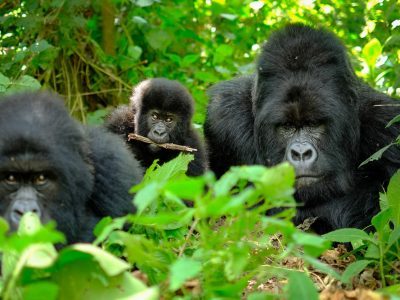
This Rwanda adventure will take you to Rwanda’s famous tourist conservation areas with the highlight being Golden Monkey trekking in Volcanoes national park, Chimpanzee trekking and Canopy walk in Nyungwe forest National park.
DAY 1: ARRIVAL TO KIGALI, HAVE A REFRESHMENT AND TRANSFER TO NYUNGWE NATIONAL PARK
Today, you will arrive at Kigali airport, have refreshment at a hotel and later set off towards the famous Nyungwe National Park which is an untouched Rainforest, one of the largest forests in East and Central Africa. The forest is abundant with flora and fauna including 13 primate species from Colobus monkeys, Mangabeys, blue monkeys and, of course, our cousins the chimpanzees. Nyungwe Forest is semi heaven for birders. With a little over 300 recorded bird species, 26 of which are endemic, making it one of the most important – and still little known – bird-watching destinations in Africa. Lunch en route or at the lodge depending on time. You will have an overnight at Nyungwe Topview Hill Hotel.
DAY 2: CHIMPANZEE TREKKING AND CANOPY WALK IN NYUNGWE FOREST NATIONAL PARK
An early morning breakfast, and later proceed to Nyungwe Forest at 6:00am to search for chimpanzee. You will also track the colobus monkeys in the forest and have a chance to view the other habitants of the forest like birds, reptiles and butterflies. Chimpanzee tracking will enable you to meet man’s closet cousins in the wild. You will be amazed to see these primates as they play, swing on tree branches, fight for food etc. This exciting up-close encounter with human’s closest relative will forever live with you. After the chimp tracking you will have an afternoon Canopy walk which takes place above a deep gorge cutting across the massive forest. Lasting about 1½ hours, the walk takes you through some beautiful foliage and animal habitats and you’ll have the chance to spot blue monkeys and unique birds that dwell in the upper levels of the forest canopy. You will have a relaxed evening plus dinner and overnight at Nyungwe Top view Hill Hotel.
DAY 3: TRANSFER TO VOLCANOES NATIONAL PARK FOR IBYIWACU CULTURAL EXPERIENCE
Breakfast and then enjoy the beautiful services and scenery at your lodge, you shall drive northeast to the town of Musanze close to the Virunga Volcano range. Here you will see the Rwanda’s Musanze caves which date back 65 million years and lay with in the volcanic region where lava flow layers long ago created the Albertine Rift Valley. In the evening, you will embark on the Iby’Iwacu Cultural Village which gives you a rare chance to meet local people, in their environment, with a taste of the culture and traditions. Be genuinely welcomed by the community as a special visitor while they proudly present to you aspects of their traditions and beliefs. Expect to have a guided community walk to visit different sites and experience the everyday lives of the local people. You will have a relaxed evening, dinner and overnight at Da Vinci Gorilla Lodge.
2 notes
·
View notes
Text
Burundi Volunteer Tours
Burundi’s geographical position has given it the name of the “Heart of Africa”. The Congo Nile Divide north of the country shares the same mountainous geography as Rwanda. To the south are tropical sandy beaches, perfect for admiring the Blue Mountains of the Congo, on the opposite side of Lake Tanganyika. This tiny country boasts 690 bird species (including Albertine Rift endemics), national…
0 notes
Note
What is your favorite kind of bird?
OH MY GOODNESS THIS IS MY SECOND FAVORITE ASK I HAVE EVER GOTTEN THANK YOU!!
Okay okay so there are several that are STRONG competitors for that title.
First let’s go with the yellow crested helmetshrike.

LOOKIT HIM!! So basically these little fellas went missing for a couple of decades because they only live in a small area of Africa called the Albertine Rift, which for a while was off limits due to the bloody Congo War. Finally, in December of 2023, a group of researchers not only spotted the birds for the first time in years, but also caught a specimen and photographed it!!! (The photo above.) Its SO cool, heres an article for ya!!
UHHHHHHH OH MY GOSH YOU'RE SO MEAN FOR ASKING ME THIS LIKE HAVE YOU SEEN THE BIRDS OF PARADISE?????
oh goodness have you seen SUN BITTERNS??? They look like BUTTERFLIES!!!
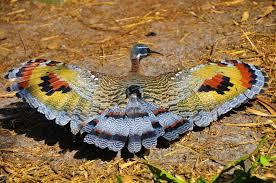

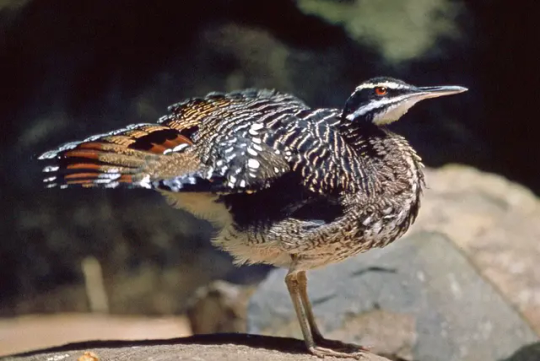

I think that African grey parrots are SUPER COOL, cuz they're super smart. Crazy intelligent. PLUS LOOK HOW RED THEIR TAILS ARE!!

They are SO smart. “They have been found to have an advanced level of cognitive power, similar to that of a four-year-old human child. They can understand cause and effect, and use tools to solve problems, such as using a stick to obtain food from a hard-to-reach place. They can even comprehend and use basic arithmetic, counting up to 8 items.” As in like. “How is a bird that clever” smart.
DO YOU EVEN COMPREHEND HOW DIFFICULT THIS IS FOR ME??? Like AAAAA.
Secretary birds kick ass, they stomp snakes to death and look really freaking cool, roadrunners can make speeds of up to 42 km/h, which is JUST under Usain Bolts speed of 44.72 km/h!!!!


Harpy eagles are SO EPIC TOOOOOOOOOO



Okay I am cutting myself off here because I could go on tangents about birds for hours, and this post would end up long enough to reach the moon and back lol.
KAKAPO PARROTS ARE CRITICALLY ENDANGERED SPECIES OF LARGE NOCTURNAL GROUND DWELLING BIRDS NATIVE TO NEW ZEALAND—
1 note
·
View note
Text
Bwindi impenetrable National Park.
Do you have a favorite place you have visited? Where is it? Is a large primeral forest in South western Uganda and is located in three districts of Kisoro,Kabale and Kanungu. The Bwindi forest is on the edge of the Albertine rift, it’s composed of both lowland and montane forest. It’s accessible on foot and a United Nations educational, scientific and cultural organization designated world…
0 notes
Text
Nyungwe National Park is a beautiful place in southwest Rwanda, next to Burundi. It is the biggest protected national park in Rwanda, covering 1,019 square kilometers. It is in the Albertine Rift, a chain of mountains and valleys along the edge of the Great Rift Valley.
The park's height ranges from 1,600 to 2,950 meters, with different kinds of ecosystems, from thick rainforests to bamboo forests, marshy areas, and open grasslands.
Nyungwe is important for Rwanda, providing water to more than 70% of the country's people. Nyungwe is a home for wildlife, including chimpanzees, golden monkeys, black and white colobus monkeys, sturdy buffalos, and more than 200 kinds of birds.
0 notes
Text

Conserving the Unique Albertine Rift Endemics: Challenges and Successes.
Severe obstacles and major gains are being made in the preservation of these one-of-a-kind Albertine Rift endemics. Considered one of the most biodiverse regions, it has many species that exist nowhere else on Earth. However, habitat annihilation created by land clearing and human encroachment jeopardizes these delicate environments. The growing pressures feed into each other and are further compounded by climate change, which shifts habitats and food sources. However, despite these difficulties, some conservation initiatives have prospered and were managed by setting up protected areas and community support. Efforts range from restoring habitat to stepping up anti-poaching campaigns. Sustainable conservation requires education and local buy-in. The need to balance human requirements with ecological preservation in order to save the distinct biodiversity of the Albertine Rift can only be met if we adhere together and do not repeat any oversight, irrespective of how small.
Phone: +256 782 531915, +256 771 664445
Email - [email protected] Visit -
1 note
·
View note
Text
Nyungwe National Park: A Pristine Rainforest Adventure

Discover the Heart of Rwanda's Biodiversity
Nyungwe National Park, a lush, verdant expanse nestled in the southwestern highlands of Rwanda, is a hidden gem waiting to be explored. As one of Africa's largest mountain rainforests, Nyungwe offers a unique blend of natural beauty, biodiversity, and adventure opportunities.
A Haven for Wildlife and Nature Lovers
Explore the Canopy Walk: Take a breathtaking walk through the treetops on Nyungwe's iconic canopy walk. Suspended high above the forest floor, this unique experience offers panoramic views of the rainforest and its diverse flora and fauna. The canopy walk is approximately 1,600 meters long and reaches a height of 70 meters above the ground.
Spot Rare Bird Species: Nyungwe is a birder's paradise, boasting over 300 species, including the elusive Albertine Rift endemic species. Keep your eyes peeled for the shy Rwenzori Turaco, the colorful Red-throated Alethe, and the elusive Great Blue Turaco. The park is home to 13 species of Albertine Rift endemic birds, making it a hotspot for birdwatchers.
Encounter Diverse Wildlife: Beyond birds, Nyungwe is home to a variety of mammals, including chimpanzees, colobus monkeys, and the elusive Lhokohola shrew. With a bit of luck, you might also encounter the endangered golden monkey, a rare and elusive primate found only in this region. The park is home to four species of great apes, including chimpanzees, gorillas, bonobos, and the Lhokohola shrew, which is endemic to the Albertine Rift.
Planning Your Nyungwe Adventure
Essential Gear and Packing Tips: Pack comfortable hiking shoes, rain gear, insect repellent, and binoculars. Don't forget to bring a camera to capture the stunning scenery and wildlife encounters.
Accommodation Options: Choose from a range of accommodations, from budget-friendly campsites to luxurious lodges. Consider your preferences and budget when selecting your lodging.
How to Get There: Nyungwe National Park is accessible by road from Kigali, Rwanda's capital city. The journey takes approximately 3-4 hours, and you can rent a car or take a guided tour.
Best Time to Visit: The dry seasons (December to February and June to August) are generally the best times to visit Nyungwe, as the weather is more pleasant and the trails are easier to navigate.
Unforgettable Activities
Chimpanzee Trekking: Embark on an unforgettable adventure to track chimpanzees in their natural habitat. Observe these intelligent primates as they swing through the trees and interact with each other. Chimpanzee trekking in Nyungwe is a popular activity, but permits are limited and must be booked in advance.
Colobus Monkey Tracking: Spot the black and white colobus monkeys, a common sight in Nyungwe's forests. These agile primates are known for their beautiful coats and acrobatic skills.
Waterfall Hikes: Discover hidden waterfalls nestled deep within the rainforest. Take a refreshing swim in the natural pools or simply enjoy the peaceful ambiance. Nyungwe is home to several stunning waterfalls, including the Kamiranzovu Falls and the Bigugu Falls.
Cultural Experiences: Immerse yourself in the local culture by visiting nearby villages and learning about the traditions and customs of the people who live in this region.
Conservation and Sustainability
Responsible Travel: Help support Nyungwe's conservation efforts by practicing responsible tourism. Avoid littering, respect wildlife, and support local communities.
Community-Based Tourism Initiatives: Learn about the community-based tourism projects that are helping to protect Nyungwe and improve the lives of local people. Nyungwe National Park has several successful community-based tourism initiatives, such as the Uwinka Community Tourism Project.
Nyungwe's Ecological Importance: Understand the critical role of Nyungwe National Park in conserving biodiversity and protecting the region's water resources. Nyungwe is home to over 1,300 plant species, including 270 tree species. The park is also a vital source of water for the surrounding communities.
Beyond Nyungwe: Exploring Rwanda
Lake Kivu: Relax on the shores of Lake Kivu, a stunning volcanic lake with crystal-clear waters. Enjoy water sports, island hopping, or simply soak up the sun.
Akagera National Park: Experience the savannah landscapes of Akagera National Park, home to a variety of wildlife, including lions, elephants, and giraffes.
Volcanoes National Park: Embark on a gorilla trekking adventure in Volcanoes National Park, another UNESCO World Heritage Site known for its mountain gorilla populations.
Nyungwe National Park offers a truly unforgettable experience for travelers seeking adventure, natural beauty, and a deeper connection with the environment. With its diverse ecosystems, unique wildlife, and rich cultural heritage, Nyungwe is a must-visit destination for anyone exploring Rwanda.
4 notes
·
View notes
Text
Why Uganda is the Hidden Gem for Birdwatching: 5 Key Highlights
If you’re passionate about birds and want a memorable adventure, Bird Watching Safaris in Uganda should top your list. But what makes Uganda a true birder's paradise? Here are the top 5 reasons why birders from across the globe flock to this East African gem.

1. Exceptional Bird Diversity Did you know Uganda is home to over 1,070 bird species? That’s nearly half of Africa’s total bird species, and almost 11% of the world’s species. With such incredible diversity, bird watching safaris in Uganda offer enthusiasts a chance to see everything from the iconic African Fish Eagle to the rare Shoebill Stork, often described as a bird straight out of prehistoric times.
Uganda’s varied ecosystems—from wetlands to forests and savannas—make it possible to spot a wide range of bird species in just one trip. Bwindi Impenetrable National Park, for instance, is a UNESCO World Heritage Site that harbors 350 bird species, including 23 Albertine Rift endemics, making it a birdwatcher's haven.
2. Unique Birding Sites Uganda’s national parks are perfect not only for viewing big game but also for birding. Queen Elizabeth National Park and Murchison Falls National Park are prime spots for bird enthusiasts, offering guided safaris where you can watch birds in their natural habitats. While many people head to East Africa for a Big 5 Kenya Safari, Uganda offers a unique twist with its focus on avian species.
The Mabamba Swamp is another standout, being one of the best places in the world to spot the elusive Shoebill. Plus, Kibale National Park boasts a remarkable population of forest birds, where species like the Great Blue Turaco and Green-breasted Pitta can be observed.
3. Experienced Birding Guides A key aspect of any successful birding safari is the expertise of local guides. Uganda is home to highly knowledgeable birding guides who are trained to help you spot even the most elusive species. Whether it’s mimicking bird calls or knowing the best time of day to view certain species, these guides make your birding experience extraordinary.
4. Rare and Endemic Species Uganda offers birders a chance to see some of the rarest and most endemic species in Africa. The Albertine Rift, a region shared between Uganda and neighboring countries, harbors over 40 endemic species that cannot be found elsewhere. Notable species include the Rwenzori Turaco and the Dwarf Honeyguide. For any avid birder, the chance to see these rare species is a major draw.
5. Birding Year-Round Unlike many destinations, Uganda offers bird watching opportunities throughout the year. With its favorable climate, many migratory species visit during the European winter, adding to the local diversity. Whether you visit in the rainy season or dry season, you’re bound to have an unforgettable birding experience.

Ready to Explore Uganda’s Birding Wonders? If you’re ready to embark on the birding adventure of a lifetime, let Nature Nest Safaris guide you. From expert-led tours to exceptional birding sites, you’ll experience Uganda’s birdlife like never before. Reach out today to start planning your next bird watching safari!
#Big 5 Kenya Safari#Bird Watching#Bird Watching Safaris#Kenya Safari#tour#Tourism#travel#wildlife safari
0 notes
Text
Discover Uganda: 18 Days of Birding and Wildlife Safari Off the Beaten Path

This 18 days Uganda birding and wildlife safari off the beaten path is the perfect choice. Uganda is a treasure trove of natural beauty and diverse wildlife, offering some of the most spectacular birding experiences in the world.
For those looking to explore less visited places of the country and truly immerse themselves in Uganda’s authentic natural wonders, with rare bird species including the Fox weavers.
This safari takes you to discover hidden gems like the Mabira forest, Mount Elgon as you go birding in Eastern Uganda. The lesser-known Pian-Upe Wildlife Reserve the only place where you can find the fox weaver and Kidepo Valley National Park for a true African wilderness safari and birding in the savannah park.
Down to Murchison Falls national park with opportunities of finding some Albertine Rift endemics, Ziwa Rhino and wildlife sanctuary and Mabamba swamp for the elusive shoebill which is a highlight for a typical Uganda bird watching tour.
The diverse landscapes and habitats we visit on this trip, also provide the opportunity to encounter a wide variety of wildlife, from majestic elephants and zebras to graceful antelopes and elusive predators.
Book Now : https://www.valiantsafaris.com/birding-safaris/18-days-uganda-birding-and-wildlife-safari-off-the-beaten-path/
#DiscoverUganda#UgandaSafari#BirdingAdventure#WildlifeSafari#OffTheBeatenPath#ExploreUganda#UgandaBirding#WildlifeExperience#AfricanSafari#NatureLovers#UgandaWildlife
1 note
·
View note